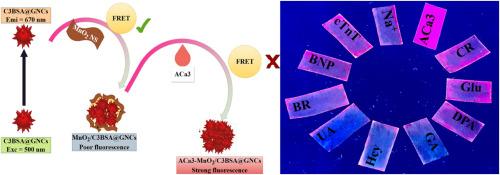二氧化锰纳米片修饰金纳米簇抗体偶联物作为一种基于fret的免疫传感器,用于选择性视觉检测Caspase-3:创伤性脑损伤的生物标志物
IF 3.6
3区 物理与天体物理
Q2 OPTICS
引用次数: 0
摘要
创伤性脑损伤(TBI)仍然是一种普遍和灾难性的疾病,是全球死亡、发病和残疾的主要原因。由于缺乏敏感的诊断工具,评估TBI是一项重大挑战。临床医生目前采用CT扫描和核磁共振扫描,这些扫描不仅昂贵且不敏感,而且农村地区无法获得,延误了及时诊断和治疗。为了克服这一限制,我们开发了一种新的基于生物标志物的检测方法来评估脑损伤,采用caspase-3作为生物标志物。为此,研制了一种基于荧光共振能量转移(FRET)的生物传感器,该传感器采用纳米二氧化锰修饰的金纳米簇抗体偶联物。在加入caspase-3抗原(ACa3)后,传感器表现出显著的荧光增强,检测限低至23 pg/mL。该研究进一步扩展到检测人血清样品中的ACa3,回收率从93%到98%不等。为了评估传感器的临床可行性并实现视觉检测,还开发了一种基于纸的试纸条,专门检测体内存在的其他竞争生物分子和离子中的ACa3。本文章由计算机程序翻译,如有差异,请以英文原文为准。

MnO2 nanosheet decorated gold nano cluster-antibody conjugates as a FRET-based immunosensor for the selective visual detection of Caspase-3: A biomarker for traumatic brain injury
Traumatic brain injury (TBI) remains a pervasive and catastrophic condition, ranking as a leading cause of global mortality, morbidity and disability. Assessing TBI poses a significant challenge due to the lack of sensitive diagnostic tools. Clinicians currently resort to CT scans and MRI scans, which are not only expensive and insensitive but also inaccessible to rural areas, delaying timely diagnosis and treatment. To overcome this limitation, we have developed a novel biomarker-based detection method for assessing brain injuries, employing caspase-3 as the biomarker. For this a a fluorescence resonance energy transfer (FRET) based biosensor was developed using gold nano cluster-antibody conjugates decorated with MnO2 nanosheets. Upon addition of caspase-3 antigen (ACa3), the sensor exhibited a significant fluorescent enhancement, achieving a limit of detection as low as 23 pg/mL. The study was further extended to detect ACa3 in human serum samples yielding a recovery percentage ranging from 93 to 98 %. To assess the clinical feasibility of the sensor and to enable visual detection, a paper-based test strip was also developed, which specifically detects ACa3 amidst other competing biomolecules and ions present in the body.
求助全文
通过发布文献求助,成功后即可免费获取论文全文。
去求助
来源期刊

Journal of Luminescence
物理-光学
CiteScore
6.70
自引率
13.90%
发文量
850
审稿时长
3.8 months
期刊介绍:
The purpose of the Journal of Luminescence is to provide a means of communication between scientists in different disciplines who share a common interest in the electronic excited states of molecular, ionic and covalent systems, whether crystalline, amorphous, or liquid.
We invite original papers and reviews on such subjects as: exciton and polariton dynamics, dynamics of localized excited states, energy and charge transport in ordered and disordered systems, radiative and non-radiative recombination, relaxation processes, vibronic interactions in electronic excited states, photochemistry in condensed systems, excited state resonance, double resonance, spin dynamics, selective excitation spectroscopy, hole burning, coherent processes in excited states, (e.g. coherent optical transients, photon echoes, transient gratings), multiphoton processes, optical bistability, photochromism, and new techniques for the study of excited states. This list is not intended to be exhaustive. Papers in the traditional areas of optical spectroscopy (absorption, MCD, luminescence, Raman scattering) are welcome. Papers on applications (phosphors, scintillators, electro- and cathodo-luminescence, radiography, bioimaging, solar energy, energy conversion, etc.) are also welcome if they present results of scientific, rather than only technological interest. However, papers containing purely theoretical results, not related to phenomena in the excited states, as well as papers using luminescence spectroscopy to perform routine analytical chemistry or biochemistry procedures, are outside the scope of the journal. Some exceptions will be possible at the discretion of the editors.
 求助内容:
求助内容: 应助结果提醒方式:
应助结果提醒方式:


